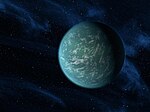WASP-39
WASP-39b is in the constellation Virgo, and is about 700 light-years from Earth. As part of the NameExoWorlds campaigns at the 100th anniversary of the IAU, the planet was named Bocaprins, after the beach Boca Prins in the Arikok National Park of Aruba.
Characteristics

WASP-39b has a mass of about 0.28 times that of Jupiter and a radius about 1.27 times that of Jupiter (91,000 km). It is a hot gas giant planet with a high temperature of 900 °C. The exoplanet orbits very close (7 million km) to WASP-39, its host star, every 4 days.
WASP-39b is also notable for having an extremely low density, near that of WASP-17b. While WASP-17b has a density of 0.13±0.06 g/cm, WASP-39b has a slightly higher density of 0.18±0.04 g/cm.
Atmospheric composition

Hot water molecules were found in the atmosphere of WASP-39b in a 2018 study. The atmospheric transmission spectra, taken by different instruments, were inconsistent as in 2021, possibly indicating a disequilibrium atmospheric chemistry. High-fidelity spectra obtained by the James Webb Space Telescope in 2022 did not confirm a disequilibrium chemistry.
WASP-39b is one of the James Webb Space Telescope's early release science targets. Sulfur dioxide was observed in this planet's atmosphere for the first time, or indeed of any planet outside of the Solar System, indicating the existence of photochemical processes in the atmosphere. WASP-39b is the first exoplanet in which carbon dioxide has been detected.
Planetary transmission spectra taken in 2022 has indicated the atmosphere of WASP-39b is partially cloudy, and planet C/O ratio appears to be subsolar. The spectral signature of water, carbon dioxide, sodium and sulfur dioxide were also detected.
WASP-39 (star)
| Observation data Epoch J2000.0 Equinox J2000.0 (ICRS) | |
|---|---|
| Constellation | Virgo |
| Right ascension | 14 29 18.4151689656 |
| Declination | −03° 26′ 40.204480380″ |
| Apparent magnitude (V) | 12.09 |
| Distance | 702 ± 2 ly (215.4 ± 0.7 pc) |
| Other designations | |
2MASS J14291840-0326403, Gaia DR2 3643098875168270592, Gaia EDR3 3643098875168270592 | |
| Database references | |
| SIMBAD | data |
The parent star WASP-39 is of spectral class G and is slightly smaller than the Sun. It lies in the Virgo constellation, 698 light-years from Earth. The star WASP-39 was formally named Malmok in 2019.
See also
- WASP-6b
- WASP-17b
- WASP-19b
- WASP-31b
- WASP-121b
- List of proper names of exoplanets (see section Sources in References)
- List of transiting exoplanets
- List of exoplanets discovered in 2011
References
- ^ Cofield, Calla; Jenkins, Ann; Villard, Ray (1 March 2018). "NASA Finds a Large Amount of Water in an Exoplanet's Atmosphere". NASA. Retrieved 3 March 2018.
- ^ "Planet WASP-39 b". Extrasolar Planets Encyclopaedia. 2018. Retrieved 1 March 2018.
- ^ Faedi, Francesca; et al. (7 February 2011), "WASP-39b: A highly inflated Saturn-mass planet orbiting a late G-type star", Astronomy & Astrophysics, 531: A40, arXiv:1102.1375, Bibcode:2011A&A...531A..40F, doi:10.1051/0004-6361/201116671, S2CID 45385573
- ^ Wakeford, H.R.; Sing, D.K.; Deming, D.; et al. (21 December 2017). "The Complete Transmission Spectrum of WASP-39b with a Precise Water Constraint". The Astronomical Journal. 155 (1): 29. arXiv:1711.10529. doi:10.3847/1538-3881/aa9e4e. S2CID 3685618.
{{cite journal}}: CS1 maint: multiple names: authors list (link) - ^ "NASA finds a large amount of water in an exoplanet's atmosphere". Phys.org. 1 March 2018. Retrieved 1 March 2018.
- ^ Adkins, Jamie (25 August 2022). "NASA's Webb Detects Carbon Dioxide in Exoplanet Atmosphere". NASA. Retrieved 28 August 2022.
- ^ Overbye, Dennis (26 August 2022). "Webb Telescope Sees a Carbon Dioxide Atmosphere Way Out There - WASP-39b, a distant world with a mass equivalent to Saturn's, is the first exoplanet known to harbor the gas". The New York Times. Retrieved 27 August 2022.
- ^ Kawashima, Yui; Min, Michiel (26 October 2021), "Implementation of disequilibrium chemistry to spectral retrieval code ARCiS and application to 16 exoplanet transmission spectra", Astronomy & Astrophysics, 656: A90, arXiv:2110.13443, doi:10.1051/0004-6361/202141548, S2CID 239885551
- ^ NASA's Goddard Space Flight Center (22 November 2022). "NASA's Webb Reveals an Exoplanet Atmosphere as Never Seen Before". Retrieved 22 November 2022.
- ^ The JWST Transiting Exoplanet Community Early Release Science Team; et al. (2023), "Identification of carbon dioxide in an exoplanet atmosphere", Nature, 614 (7949): 649–652, arXiv:2208.11692, Bibcode:2023Natur.614..649J, doi:10.1038/s41586-022-05269-w, PMC 9946830, PMID 36055338
- ^ Rustamkulov, Zafar; et al. (2023), "Early Release Science of the exoplanet WASP-39b with JWST NIRSpec PRISM", Nature, 614 (7949): 659–663, arXiv:2211.10487, Bibcode:2023Natur.614..659R, doi:10.1038/s41586-022-05677-y, PMC 9946832, PMID 36623548
- ^ Ahrer, Eva-Maria; et al. (2023), "Early Release Science of the exoplanet WASP-39b with JWST NIRCam", Nature, 614 (7949): 653–658, arXiv:2211.10489, Bibcode:2023Natur.614..653A, doi:10.1038/s41586-022-05590-4, PMC 9946836, PMID 36623551
- ^ Alderson, Lili; et al. (2023), "Early Release Science of the exoplanet WASP-39b with JWST NIRSpec G395H", Nature, 614 (7949): 664–669, arXiv:2211.10488, Bibcode:2023Natur.614..664A, doi:10.1038/s41586-022-05591-3, PMC 9946835, PMID 36623549
{{citation}}: CS1 maint: multiple names: authors list (link) - ^ "Approved names". NameExoworlds. Retrieved 2 January 2020.
- ^ "International Astronomical Union | IAU". www.iau.org. Retrieved 2 January 2020.
External links
![]() Media related to WASP-39b at Wikimedia Commons
Media related to WASP-39b at Wikimedia Commons


